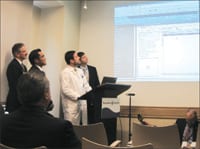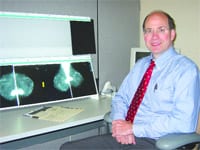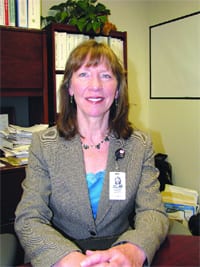The Road to Progress Getting Up to Speed on the Massachusetts Health Information Highway
Organizers called it a “golden-spike event.”
That’s a reference to that historic ceremony at Promontory Point, Utah, in May 1869, when the Central Pacific and Union Pacific Railroads were joined, marking the completion of the Transcontinental Railroad.
On Oct. 16, another significant connection was completed — this one via videoconference. It was the launch of a secured line of communication between two large health care systems — Massachusetts General Hospital and Baystate Health, which took the first official trip on the Massachusetts Health Information Highway, or HIway. The HIway, through the Massachusetts Health Information Exchange (HIE), facilitates the secure transmittal of clinical information among health care information systems, while maintaining the meaning of the information, regardless of provider affiliation, location, or differences in technology. The HIway allows doctors and other clinicians a more comprehensive understanding of their patients’ full medical histories.
On this first demonstration of the HIway, the information transmitted was the full medical record of Mass. Gov. Deval Patrick. And while it was only a click of a mouse, the impact of what transpired was not lost on those who witnessed the event, including the governor and a host of civic, business, and healthcare leaders. This was an important first step on the road to creating a more coordinated — and connected — system of healthcare.
“This is just the beginning of a long journey; it’s very rudimentary what we just demonstrated,” said Dr. Evan Benjamin, senior vice president of Healthcare Quality at Baystate Health, who officially received the governor’s secure records at Baystate seconds after transmission. “If you consider a telephone conversation as a true interaction, this is the dial tone that we just established.”
More specifically, what was essentially established is the manifestation of ’meaningful use’ of electronic medical records (EMR), the monumental move from paper to iPad or tablet and then to a secure computer software system.
For this issue and its focus on information technology, HCN talked with many of those on hand to drive in this ’golden spike’ and explain its significance in terms of improving the delivery and overall quality of healthcare in the Bay State.
Moving in the Right Direction
When asked about the significance of EMR, those we spoke with said it comes down to one thing: getting important information into the hands (or computers) of those who need it as quickly and efficiently as possible, and in a secure manner.
“Information exchange helps us get that patient information to the right individual, meaning the PCP [primary care physician], the care manager, or specialist at the time prior to an actual incident,” said Joel Vengco, vice president of Information Services and chief information officer at Baystate Health.
He offered a simple example of how EMR is utilized within the HIway: a patient doesn’t pick up his medication from the pharmacy, which was posted four days ago. Through the EMR collaborative system, that non-event should trigger an alert to the patient’s PCP, identifying a risk factor that could result in an adverse event. Eventually, over time, as the system evolves and deepens into the patient’s approved contact medium, the patient will be alerted as well.
From the medical side, Benjamin added, “as physicians, there is a lot of information that we need, and we would love to have EMRs which are truly ’interoperable’ — in other words, it looks and feels like one medical record, regardless of where the patient is. But we’ll also settle for any information we can get at this point, to start building it.”
Which brings him back to the successful electronic transmission of the governor’s medical record, and what such exchanges can mean it terms of everything from patient care to reducing the cost of that care.
If the governor, who owns a home in Western Mass., should be in a car accident or suffer another trauma, Baystate, being the only Level 1 trauma center in this region, would most likely be where emergency units would bring him. “If the governor showed up unconscious in our emergency room, knowing his medical history and allergies would be very helpful for us,” said Benjamin.
Having such a full history can also help reduce duplicative procedures, he continued, and thus bring down the cost of providing care. “Today that duplicative procedure is costly to the patient,” Vengco said. “Tomorrow it becomes an unpaid procedure if Medicare gets claims for two of the same tests within a certain criteria of time; one of those tests won’t be paid and will become an expense to the institution.”
With duplicative procedures under control, Benjamin added, the quality of care is improved, the coordination of care is certainly streamlined, and costs are naturally cut for both patients and physicians’ offices and healthcare systems.
Learning Curve
While Baystate has been using EMR since 1998, other healthcare practices haven’t been as swift to accept new technology.
“The hardest change is just the implementation of the EMR. When you begin going from paper to electronic, there is a learning curve,” said Benjamin. “It involves changes in how patients are seen in practices, how the documentation is managed, how medications are ordered, so there is no more paper floating around, no more scripts to the pharmacy.”
This is an intrusive technology for physician workflow,” noted Vengco. “They have a flow they’ve learned in school, and to put a computer, iPad, or tablet in front of them really sort of detracts from what they feel is true patient care. But the federal government says this is the price of doing business as a clinician.”
And the state does as well. In 2008, it passed a law requiring hospitals to use EMR and doctors to become competent using the technology by 2015. The same law also mandates hospital use of computerized physician order entry (CPOE) systems by October 1, 2012. As part of their licensure requirements, doctors will have to demonstrate competence in the use of CPOE, e-prescribing, EMR, and other forms of health IT by the beginning of 2015.
Both Benjamin and Vengco say the return on investment of the law’s demands will become clear, especially in the area of time.
Typically, patients’ medical records, in binders and folders, are transferred by mail, fax, or “sneaker net,” which is what Vengco called walking the patient file across the parking lot. And, in an emergency situation, time is one thing a doctor doesn’t have.
Vengco and his IT team at Baystate, now has a Golden Spike Award from the governor to put on their wall. They consider this first true exercise of meaningful use, a simple, yet strong and solid foundation from which to build.
“I think we are the first to have this type of baby-step approach, but it’s not a new idea,” said Vengco. “Other regions around the country have done this but have taken leaps where we are taking small steps.”
He was referring to other areas in the nation that have tried, and failed, to create this electronic sharing of medical records but went too fast with systems that were too complex and that didn’t have buy-in from all involved, which is vitally important, according to both Vengco and Benjamin.
In the case of the Mass. HIway, involvement is not an issue; there’s plenty.
The HIway was developed by the Massachusetts eHealth Institute at the MassTech Collaborative with the support of many partners, including Baystate, and funded though a state request for a combined $16.9 million from the Obama administration’s American Recovery and Reinvestment Act (ARRA) and Medicaid.
Vengco explained to HCN that $700,000 of that ARRA/Medicaid funding initiated the Mass HIway, which the membership will have to match annually — the membership being all health systems, individual physicians, specialists, etc., but on a sliding scale, based on size of company.
This is where affordability comes in to play for Massachusetts participants. Part of the failure in other states is due to the overwhelming cost of healthcare processes. In the case of the HIway, the large grant and then the plan for a sliding scale of annual membership fees will ensure the future of the plan.
“What’s happening here now with the Mass HIway is that the accessibility is being spread across the membership, and it’s scaled to incorporate the affordability of the smaller practices,” said Vengco. “So even if a small practice isn’t fully operational yet with EMRs like a larger entity, they can still receive an e-mail with a patient’s information, but in a secure fashion.”
Vengco offered a modest ballpark example: Baystate’s fee may be around $30,000 to $40,000, while a small practice would be closer to $1,000.
Fast Track
The future goal of EMR is to be able to actually click on the patient record and see past X-ray images and read the results of past blood tests or the outcome of surgical procedures. While the timeline of that is still unclear, Benjamin is sure that a local initiative, the Pioneer Valley Information Exchange (PVIX), will be on a faster track than the state Mass HIway, due to Baystate’s proprietary system, an integrated health system medical record.
“The PVIX will start with the EMRs that exist here in the Pioneer Valley and connect those, because they are fewer in number and Baystate Health is the dominant provider, with three hospitals and 500 physicians; it will help us to begin this journey of health information exchange faster,” Benjamin explained to HCN. “Ultimately, the PVIX will hook up to the state’s system.”
Vengco added, “we actually share more patients, obviously, between and among each other than we would between us and Mass General or Brigham and Women’s, so we are doing that here at Baystate for our region.”
But the PVIX also attacks the issue of competition. “Historically, doctors believed that patient data was a competitive advantage, but it’s so not the case. And culturally, it still hasn’t truly changed, but it’s what you do with that data,” Vengco said. “For the sake of the patient, we should exchange data because it will create better-quality care.”
Referring back to the baby steps recently taken, Vengco said that, because east has met west in the secure intranet of the Mass HIway, it now behooves the smaller communities, all around Boston and Springfield and certainly in between the two, to take their own baby steps in secured medical communications to the next level.
“Today, we are an industry focused on episodic care, meaning patients visit when they are sick; in the future, we have to look at how we care for them longitudinally, over time as a population, rather than as individual patients,” said Vengco. “Eventually, as we layer patient-engagement portals on top of the health-information exchange, we will have that capability to really promote self-management by patients.”
Benjamin believes the public sees the healthcare industry lagging behind the times and slow to adopt electronics like other industries — like banking through an ATM — but those same protections are in the EMRs and the new HIway.
Considering industry perception, safety concerns, and the grand goals of the golden-spike event, he added, “people have really come together across organizations, public and private, competitors and non-competitors, to recognize that this is the way we have to do business to improve the efficiency of the entire healthcare system. So I think it’s seen as less of a competition issue, but one in which all boats rise with the high tide.”
And if the baby steps continue, the Mass HIway will be a very busy, and efficient, place.



